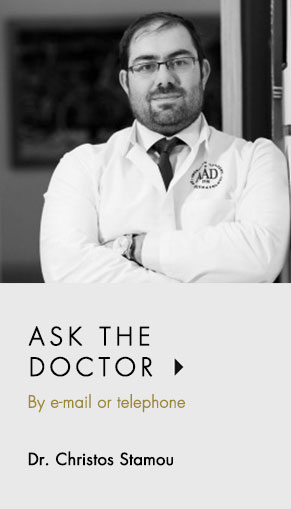Laser therapy, Injection (sclerotherapy) or combination


The more painless treatment, immediate return to daily routine

Immediately visible result (in a few weeks)

Personalized Therapeutic Plan by Vascular Surgeon & Dermatologist
What are spider veins?
Spider veins or telangiectasias are small dilated blood vessels near the surface of the skin or mucous membranes, with a diameter of 0.5 – 1 mm.
What causes spider veins?
Spider veins are the result of weak or damaged valves in the veins. When the valves do not open to allow blood to leave the veins, blood backs up and the veins swell.
A number of factors increase the risk of developing this condition, including the following:
- Ageing
- Heredity (family history of the condition)
- A history of blood clots
- Taking oral birth control pills
- Hormonal changes during puberty or menopause, or hormone replacement therapy
- Pregnancy
- Standing or sitting for many hours
- Wearing too tight clothing or a girdle
- Obesity
- Constipation
- Over-exposure to the sun especially with fair skin tone
- Injury
- Exposure to ultraviolet radiation
- Waxing for Hair Removal
- Acne Rosacea
Other risk factors for spider veins
Spider veins develop more commonly in women as compared to men. Their incidence increases with age. It is estimated that 30% to 60% of adults have spider veins.
Symptoms of spider veins
The most obvious symptoms of spider veins are their web-like appearance on the skin. These veins can be red, blue or purple. Other symptoms include:
- Uncomfortable feeling in the legs
- Swelling
- Rash
- Throbbing, cramps or pain
- Itching around the veins
- Skin ulcers
Visit your doctor if:
- Your veins become warm and sensitive on touching
- Your veins cause you pain
- You have sores, rashes or ulcers on your ski
- Your spider veins are bleeding
Treatment of spider veins
If you have symptoms or you want the removal of your spider veins for aesthetic reasons, a trained doctor will suggest the right treatment for your condition. Treatment options include:

- Sclerotherapy: This common treatment is used for both spider veins and varicose veins in the legs.In this procedure, the doctor infuses a chemical substance into the veins so as to make them shut. Without blood flow, the vein turns into scar tissue and finally fades away. The treatment is repeated every four to six weeks.
- Laser treatments: This procedure is usually applied on the face, and the laser is used to send light pulses through the skin to the vein or vessels, making them weaker gradually.
Treatment of Spider Veins with Sclerotherapy
Sclerotherapy is the most common and widely used treatment for spider veins and varicose veins. A needle is used to infuse a chemical substance into the vein. The chemical causes the vein walls to swell, stick together, and seal shut. This stops the flow of blood, and the vein turns into scar tissue. In a few weeks, the vein should fade.
This treatment is performed without anaesthesia. You can return to your normal activities immediately after treatment.
The same vein may have to be treated more than once. Sessions are repeated every 4 to 6 weeks. This treatment is very effective if applied correctly. Possible side effects:
- Stinging, redness and mild swelling of the skin or bruising at the injection site. Symptoms usually go away shortly after treatment.
- Spots, brown lines, or groups of fine red blood vessels around the treated vein. These also usually go away shortly after treatment.
- Blood clots that get trapped in the vein and cause inflammation that is not dangerous. You can relieve swelling by applying heat and taking aspirin.
Treatment of spider veins with laser
In some cases, lasers can effectively treat spider veins. This technique sends very strong bursts of light through the skin onto the vein. This targeted heat gradually destroys the vein.
No needles or incisions are used, but the heat from the laser can be quite painful. Cooling helps reduce the pain. Each session usually lasts between 15 and 20 minutes. To remove the spider veins in the legs, 2 to 5 sessions are required. You can return to your normal activities straight after the treatment session.
Possible side effects:
- Redness or swelling of the skin immediately after treatment, which subsides within the next days
- Skin depigmentation that is not permanent; skin colour becomes normal within one to two months
Is spider veins treatment permanent?
Current therapies for spider veins have very high success rates in comparison to older therapies. However, after several months have passed, spider veins may reappear, because there is no treatment for weak veins and vessels.
To slow down or even reduce the chance of recurrence, the patient should reduce the risk factors such as obesity, standing up, and prolonged exposure to the sun.


